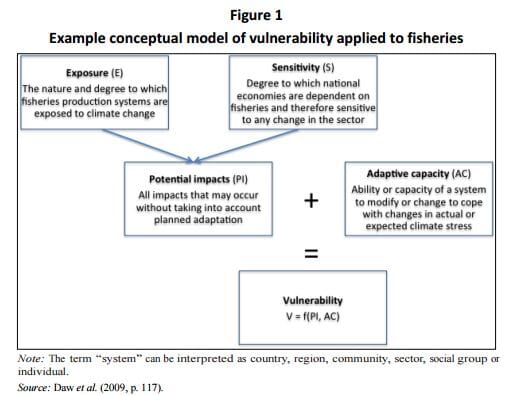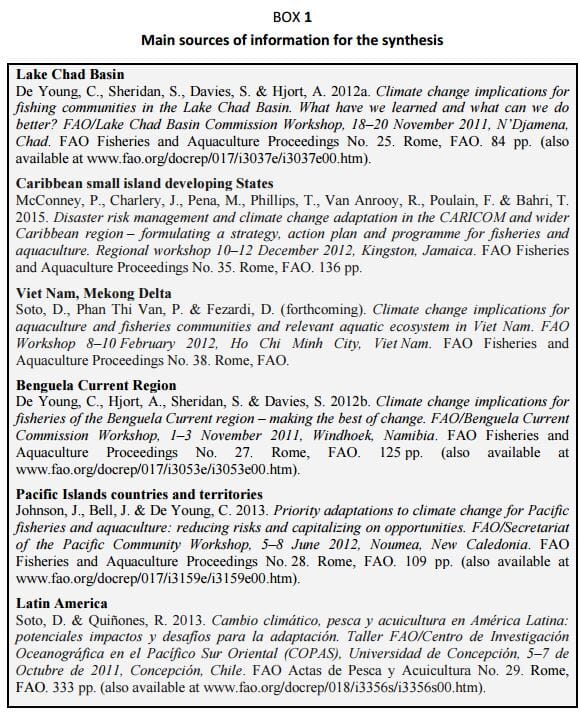Background
Aquatic systems, both marine and freshwater, have been recognised as vital in provisioning, regulating and supporting a wide range of services for humankind. However, climate change is a growing threat to the continuous provision of these services.
The implications of this global challenge to the sustainability of fisheries and aquaculture and the livelihoods and economies that depend on them have been receiving increasing attention.
It is now recognised that sea-level rise, ocean acidification and changes in salinity, precipitation, groundwater and river flows, water stresses and extreme weather events are changing the productivity of aquatic habitats, modifying the distribution of both marine and freshwater fish species, and affecting the seasonality of biological and biophysical processes.
The Intergovernmental Panel on Climate Changedefines “vulnerability” as “the degree to which a system is susceptible to, and unable to cope with, adverse effects of climate change”.
Using this framework of analysis, global studies have highlighted the relative vulnerability of national economies to any potential change in their fisheries from climate change, and found that the most vulnerable tended to be least-developed countries, where the capacity to adapt may be most limited.
This finding emphasises the fact that not only will livelihoods and national economies need to cope with immediate changes and trade-offs imposed by climate change, but they will also need to evolve in a way that allows them to develop positive adaptation mechanisms and seize the opportunities that may arise from climate change impacts in the medium to longer term.
In the last few years, much conceptual and applied work has contributed to increasing the understanding of the characteristics of “vulnerability” in fisheries and aquaculture systems, as well as in a range of other contexts.
The IPCC definition of vulnerability – decomposed as a function of exposure, sensitivity and adaptive capacity – tends to be used as a starting point for most analyses, either in its original form or specifically tailored to fisheries and aquaculture (Figure 1).
However, assessments can be divided into two broad categories: those that focus on predicting biophysical risks and hazards created by climate change and the responses of systems, usually relying on quantitative, top-down investigative methods (e.g. modelling); and those that focus on understanding the impacts of climate change on human systems, usually examining what is referred to as “contextual vulnerability” and relying on bottom-up, stakeholder-based investigative approaches (Brugère and De Young, forthcoming).
FAO regional case studies
Global reviews of the impacts of climate change on fisheries and aquaculture systems carried out in 2009 revealed a paucity and patchiness of information concerning climate impacts on the sector.
Six follow-up regional case studies were then launched by the Food and Agriculture Organization of the United Nations (FAO) in an attempt to start filling the gaps and to provide direction and initial steps in adaptation planning.
Fisheries and aquaculture systems were selected across the globe to allow for diversity. The approach of the case studies followed a template allowing them to:
(i) define vulnerability to climate change by understanding potential impacts on the system, the sensitivity of the system to such changes and the current adaptive capacity;
(ii) identify gaps in existing knowledge in assessing the vulnerability of the system;
(iii) identify potential strategies for reducing vulnerability to climate change; and
(iv) provide policy guidance in reducing system vulnerability.
However, authors were allowed flexibility in defining the system, issues and options, according to the prevailing conditions of the area or system under study.
The case studies were desk-based and relied mainly on available secondary information. Each case was subsequently discussed with a range of stakeholders in six regional follow-up workshops.
Synthesis of the case studies
Preparation of this synthesis relied on the proceedings of six regional workshops on climate change vulnerability and adaptation in fisheries and aquaculture (Box 1), held in Barbados, Chad, Chile, Namibia, New Caledonia and Viet Nam in 2011 and 2012.
The in-depth regional analyses prepared for each workshop – of the vulnerability of fisheries and aquaculture systems and the livelihoods and economies they support – were extensively reviewed and used as the main sources of information for this synthesis.
Moreover, the analytical process that underpinned the synthesis was guided by the outcomes of two recent FAO workshops on climate-change vulnerability assessment for the fisheries and aquaculture sectors.
Synthesis goal and objective
The goal of this synthesis is to raise awareness of the need for vulnerability assessment work in fisheries and aquaculture.
In addition, it is hoped that it will help share what issues were raised in these case studies and what adaptation options were proposed in order to support interregional learning.
On this basis, the specific objective of this publication is to consolidate, further interpret, refine and draw conclusions from the information gathered on climate change impacts, sensitivity and adaptive capacity of fish production systems in the diverse and geographically distinct social-ecological systems covered by the six case studies.
Diverse components of the fisheries and aquaculture systems (human and/or environmental) are vulnerable to different climate-related threats, as well as to anthropologically driven ones (e.g. overfishing).
The need for context-specificity precludes any generic statement about the vulnerability status of fisheries and aquaculture systems, and of their associated human systems. Despite this, the case studies confirmed that ecosystem resilience and human adaptive capacity were the two major determinants of vulnerability, and that governance was itself a determinant of adaptive capacity.
More context-specific vulnerability assessments of fisheries and aquaculture are needed, in particular in areas where such studies have not been carried out.
However, in areas where vulnerability information is already available, as in the six areas covered here, this information could be used, first, as a baseline, and second, as a stepping stone to move on from vulnerability characterisation to decisions on adaptation actions.
“Good” adaptation decisions may be perilous to make. However, considering what lies behind them appears to be a conducive strategy to ultimately understanding and addressing those barriers that can “stop, delay or divert the adaptation decision-making process” at any stage.
Documenting determinants of and barriers to adaptation, and in particular the governance and institutional issues that tend to underpin them, will aid progress towards a better understanding of vulnerability, ecosystem resilience and human adaptive capacity, and will support the design of effective, efficient, legitimate and equitable adaptation actions.
Finally, concerns about climate change impacts on fisheries and aquaculture systems, and a focus on the need for these to adapt, should not move attention away from their management.
Indeed, the case studies highlighted that, in some cases, it is overfishing that is threatening the fishery, not climate change or even other environmental factors. Unless urgently addressed, this could weaken the very basis on which future adaptation will rely.
August 2015




